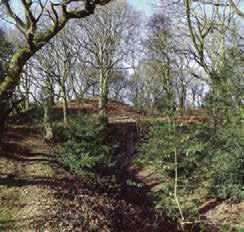
4 minute read
Pets
from Voice Magazines - Broadmeadows, South Normanton, Blackwell, Newton & Hilcote Edition - July 2021

PET SERVICES
Advertisement
Pets






















GET IN TOUCH 07411 735 727
@chloejadedogwalkingservices
chloejadedogwalkingservices@gmail.com
Positive Reinforcement Dog Training
Sit - One to one dog training Stay - House visits & pet sitting Walkies - Dog walking
With 30 years experience and qualifica�ons in pet first aid, feline & canine behaviour and dog training, I offer a professional and friendly service tailored to your needs - from helping with a naughty dog to puppy training, dog walkinwalking, house visits or pet taxi services. Please give me a call to discuss your requirements.
Call Sco� on 07929 208507
sco�@ssw.training www.ssw.training
Pinxton & South Normanton History Group THE VILLAGES FORGOTTEN GEM
When was it built, by whom and why?
The castle is listed by English Heritage as a monument of National Importance (National Monument Number 23295). It is situated just south of the A38 adjacent to McArthur Glen Retail Outlet. It is to your left of the entrance road to the outlet car park.
It is unusual in two ways, 1) the site has remained undisturbed through the ages, 2) it was double moated, which is rare.
The construction was of the motte-and-bailey type of castle. This design was brought from France by William the Conqueror and was responsible for his success in conquering England. It was relatively quick and easy to build sometimes with local unskilled forced local labour. The concept is quite simple. You dig a ditch and heap the extracted soil. A six foot ditch heaped will provide a twelve foot difference in height. Put a ring of spiked timber poles on top and you have an effective defensive structure.
Most people will know of Windsor Castle and York Castle to name but two of the better known surviving structures; both were motte-and-bailey castles. Pinxton castle, was, of course, a much smaller structure.
The motte was usually constructed within and surrounded by the bailey. The bailey was the outer courtyard which house living quarters and stables. Being a double moated structure the motte of Pinxton’s castle was also surrounded by a moat as was the bailey (thereby being double moated).
Only a small percentage of the total five hundred or so known motte and bailey castles were double moated. The castle bailey was entered over a bridge. There would have been another bridge over the moat to the motte. The inner moat was also used to farm fish to supplement the supply of meat, particularly during the winter months.
The castle was built in 1150; an engraved stone carrying the date was excavated from the site in the early 1950’s. This was during the time of the Le Wynn family. The le Wynn’s were Lords of the Pinxton Manor under the overlords of the region, the Grey family, one of whose descendants was Lady Jane Grey who was Queen of England for nine days and who lost her head as a result. Not a lot of people are aware that The East Midland Retail Outlet is in Pinxton, although it can only be entered from South Normanton Parish. The boundary in this area is totally inconsistent, due to the historic importance of the castle site.
Why was it built? The answer to this would appear to be because of the conflict being experienced in the country at that time. It is usually called ‘the period of anarchy’ by historians. This was the first major conflict following the Norman Conquest. This was a series of battles between the supporters King Stephan and the Emperess Matilda (the grand-daughter of William the Conqueror). The war was in danger of de-stabling the whole of the country when local leaders were flexing their muscles and taking things into their own hands.
The official description of the site states, ‘the castle includes the motte of a twelfth century earthwork castle and a later medieval fortified manor. The remains include a moated site and five fishponds along with a range of perimeter earthworks. The motte comprises a three metre high conical mount whose lever summit has a diameter of about twenty metres. It would have been the site of a shell keep – a type of early castle.


Photograph as requested of the site as it appears today. The image shows (centre) the site of the Motte with the location of part of the moat (on the right)


